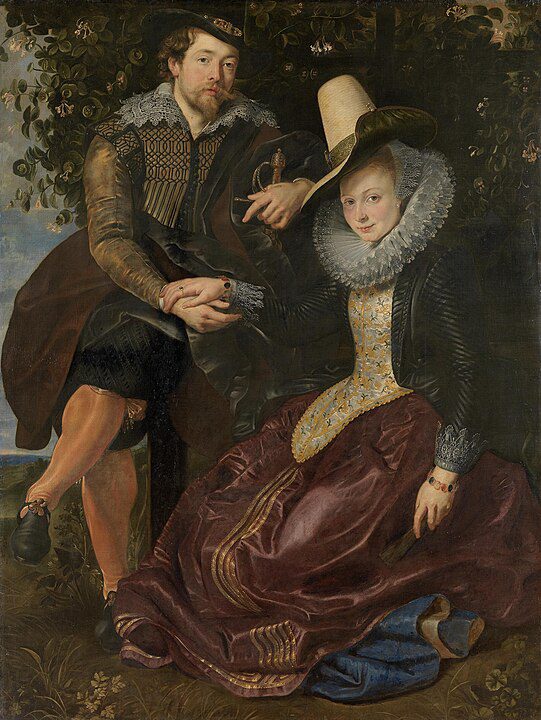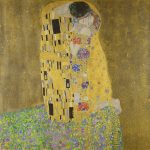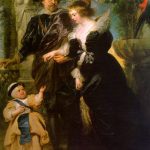
Peter Paul Rubens is celebrated not only as one of the greatest artists of the Baroque period but also as a man whose personal life intertwined deeply with his work. Among the key figures who shaped his life and career, his first wife, Isabella Brant, stands out as a profound influence. Their marriage wasn’t merely a union of love but one that left a lasting imprint on Rubens’ artistry. Throughout their relationship, Isabella appeared in his works not just as a model but as a muse whose presence illuminated his canvases with warmth, grace, and affection.
Rubens’ portraits of Isabella are far more than just images of a beautiful woman—they tell a story of devotion, partnership, and shared ambition. Through these works, Rubens expressed his deepest emotions, making Isabella one of the most memorable subjects of his illustrious career.
Meeting and Marriage: Peter Paul Rubens and Isabella Brant’s Early Life Together
Rubens met Isabella Brant in Antwerp after an eight-year sojourn in Italy, where he studied the works of Renaissance masters. By the time of his return in 1608, Rubens was already establishing a name for himself as a master of Baroque art, known for his grand historical and religious scenes. Antwerp, at the time, was a thriving hub of trade, culture, and intellectual discourse, making it the perfect place for Rubens to continue growing his career.
Isabella came from an influential and respected family in Antwerp. Her father, Jan Brant, was a prominent lawyer and humanist, well connected in intellectual and political circles. This upbringing gave Isabella an education and grace that perfectly complemented Rubens’ own ambitions. Their marriage, which took place in 1609 at St. Michael’s Abbey in Antwerp, was a union of love and mutual respect, but it also elevated Rubens’ social standing, opening doors to new opportunities for commissions from the elite.
While their union helped Rubens navigate the world of Antwerp’s upper class, it was their deep affection for each other that stood out. This was not just a marriage of convenience; it was a partnership that balanced love and ambition. Isabella quickly became not only his wife but also his muse and the source of inspiration for some of his most intimate portraits.
The Honeysuckle Bower: A Symbol of Love and Devotion
One of the most famous portraits Rubens painted of Isabella is The Honeysuckle Bower (1609). This intimate double portrait, created shortly after their marriage, captures the couple seated together beneath a bower of honeysuckle, a plant symbolizing love and fidelity. The composition, warm and full of life, shows Rubens and Isabella sitting side by side, their hands gently intertwined—a representation of their unity and partnership.
The portrait is filled with symbolism. The honeysuckle, blooming vibrantly above them, represents the enduring nature of their love, while their relaxed poses and calm expressions convey a sense of peace and contentment in each other’s company. Rubens’ use of light bathes Isabella in a soft glow, highlighting her beauty while emphasizing her significance in his life. Unlike the grand, formal portraits of the time, The Honeysuckle Bower is deeply personal, capturing the tender bond between the artist and his muse.
This portrait also represents Rubens’ mastery of creating intimate works that go beyond mere likeness. By infusing the portrait with emotion and symbolism, Rubens was able to immortalize his feelings for Isabella, making the painting not just a work of art, but a visual testament to their love.
Isabella Brant in a Fur Wrap: Elegance and Intimacy
Another key portrait of Isabella is Isabella Brant in a Fur Wrap (circa 1620), where Rubens captures his wife with a sense of regal elegance. Draped in luxurious fur, Isabella is presented not only as a figure of wealth and status but also as someone who embodies warmth and protection—qualities that defined her role in Rubens’ life.
In this portrait, Rubens’ attention to detail is striking. The fur wrap, softly illuminated by light, seems to glow against Isabella’s skin, providing both a tactile and emotional richness to the work. Her calm, composed expression reflects the grace and poise that she brought to Rubens’ personal and professional life. Here, Rubens’ ability to capture the essence of his subject is on full display. Isabella is not simply a model; she is a representation of the emotional and intellectual support that allowed Rubens to pursue his ambitions.
Isabella’s Role in Rubens’ Career: More Than a Muse
Isabella Brant’s influence extended far beyond her role as Rubens’ muse. She was integral to his career, providing both emotional and logistical support. While Rubens was one of the most successful artists of his time, he was also a diplomat, often traveling to foreign courts on behalf of the Spanish Netherlands. During his long absences, it was Isabella who maintained their household and took care of their growing family.
In addition to managing the home, Isabella played an important role in Rubens’ professional life. Their home in Antwerp became a meeting place for artists, intellectuals, and dignitaries, where ideas were exchanged, and new connections were made. Isabella’s social grace and intelligence allowed her to navigate these circles with ease, helping Rubens to build and maintain relationships with powerful patrons across Europe.
Their marriage was a partnership in every sense of the word. Isabella provided Rubens with the stability he needed to pursue his artistic and diplomatic careers, allowing him to focus on his creative projects while she ensured that their home life remained stable and harmonious.
Family Life: The Children of Peter Paul Rubens and Isabella Brant
Together, Rubens and Isabella had three children: Clara Serena, Albert, and Nicolaas. Family life was central to Rubens, and his love for his children is evident in the many intimate portraits he painted of them. These works, characterized by warmth and tenderness, offer a glimpse into Rubens’ private world and the strong bond he shared with his family.
Rubens’ portrait of Clara Serena, his eldest daughter, is particularly touching. Painted when she was just a child, the portrait is filled with affection, capturing her innocence and the father’s love. This painting, along with others depicting his children, demonstrates the importance of family in Rubens’ life and the influence that Isabella had in creating a nurturing, loving environment.
Isabella’s role as a mother was as crucial as her role as a wife. She ensured that their children were raised in a culturally and intellectually stimulating environment, which allowed Rubens to balance his demanding professional life with a fulfilling family life. This balance is evident in the works he produced during their marriage, which are filled with both grandeur and intimacy.
Tragedy and Loss: The Death of Isabella Brant
In 1626, Isabella Brant died at the age of 34, likely due to the plague that ravaged Europe during that period. Her death was a devastating blow to Rubens, who had spent 17 years with her as his wife, muse, and partner. The loss of Isabella marked a turning point in Rubens’ life, and this profound grief is reflected in his later works.
Following Isabella’s death, Rubens’ work took on a more somber and contemplative tone. The vibrant, joyful paintings of his earlier career gave way to more melancholic themes, as he processed his grief through his art. His religious works from this period, particularly his depictions of the Virgin Mary, are imbued with a sense of sorrow and loss, reflecting the deep emotional void left by Isabella’s absence.
Though Rubens remarried in 1630 to Hélène Fourment, his second marriage did not carry the same emotional intimacy that characterized his relationship with Isabella. The impact of her death lingered with Rubens for the rest of his life, shaping both his personal and artistic legacy.
Isabella’s Lasting Legacy in Rubens’ Art
Isabella Brant’s legacy lives on through the portraits Rubens painted of her and the lasting influence she had on his work. As both his muse and his partner, she played a central role in his life, and her image continues to captivate art lovers and historians alike. Her portraits are some of the most personal and emotionally resonant works in Rubens’ catalog, offering a glimpse into the private life of one of the most famous artists in history.
Rubens’ depiction of women, both in his portraits and his allegorical works, was deeply influenced by Isabella. Her grace, beauty, and strength became the standard for many of the female figures in his paintings, making her an enduring figure in the art world.
A Love Immortalized in Art
The love story of Peter Paul Rubens and Isabella Brant is one of devotion, partnership, and artistic inspiration. Their marriage was more than just a personal relationship—it was a collaboration that influenced some of Rubens’ most iconic works. Though their time together was tragically cut short, Isabella’s presence continued to resonate in Rubens’ art long after her death.
Today, as we look upon Rubens’ portraits of Isabella, we are reminded not just of the skill of a master artist, but of the powerful bond between two people whose love transcended the canvas.
FAQs
- Who was Isabella Brant?
Isabella Brant was the first wife of Peter Paul Rubens, an influential Baroque artist. She was his muse, partner, and the subject of many of his most intimate portraits. - How did Rubens meet Isabella Brant?
Rubens met Isabella in Antwerp after returning from Italy. They married in 1609 and shared 17 years of marriage until her untimely death. - What is The Honeysuckle Bower?
The Honeysuckle Bower is one of Rubens’ most famous portraits, depicting him and Isabella soon after their marriage. The painting symbolizes their love and partnership. - How did Isabella Brant influence Rubens’ work?
Beyond being his muse, Isabella supported Rubens’ career by managing their household, hosting social gatherings, and helping him establish connections with influential patrons. - What happened to Isabella Brant?
Isabella Brant died in 1626, likely due to the plague. Her death had a profound effect on Rubens, and his later work reflects the grief he experienced after her passing.
Key Takeaways
- Peter Paul Rubens and Isabella Brant shared a deep and lasting bond that influenced both his personal life and his artistic career.
- Rubens’ portraits of Isabella, especially The Honeysuckle Bower, are intimate depictions of their love and partnership.
- Isabella played a crucial role in Rubens’ career, managing their household and helping him navigate the political landscape of 17th-century Europe.
- The death of Isabella in 1626 deeply affected Rubens, and his grief is reflected in his later works.
- Isabella’s legacy continues through the portraits Rubens painted of her, cementing her place in art history.




